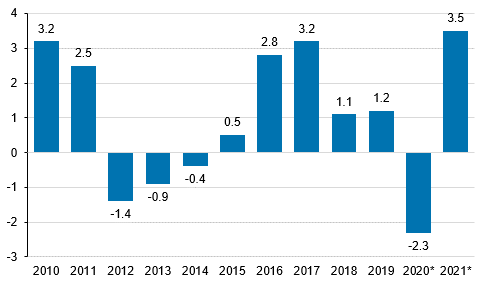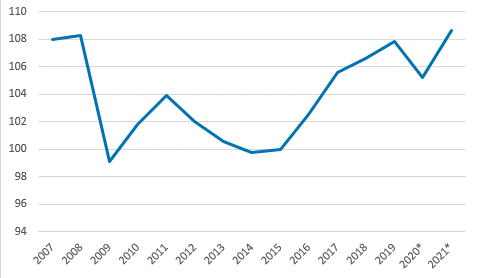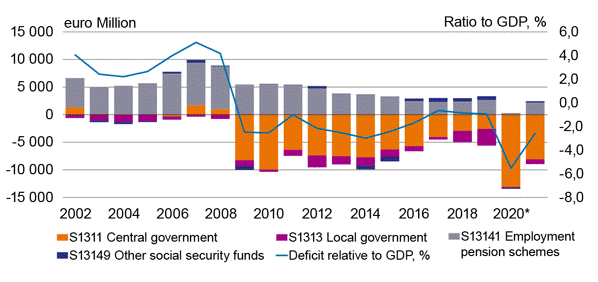Published: 15 March 2022
Gross domestic product grew by 3.5 per cent in 2020
According to Statistics Finland’s preliminary data, the volume of Finland’s GDP rose by 3.5 per cent in 2021. The growth became slightly revised from February’s quarterly national accounts as government finance data were updated (was -3.3 per cent). Gross domestic product per capita exceeded the level prior to the financial crisis.
Annual change in the volume of gross domestic product, per cent

Private consumption returned to growth track in 2021 — the corona slump in consumption was short-lived
Private consumption was again clearly growing in 2021 after the temporary slump in 2020. The level of private consumption now rose to a clearly higher level than prior to the corona crisis. The impact of the coronavirus on private consumption growth was thus short-lived.
Households' saving rate returned to the customary level of 1.2 per cent in 2021. Private consumption grew but, on the other hand, household disposable income also grew as employment increased clearly. In 2020, households' saving rate was still exceptionally high, as private consumption decreased more than household disposable income.
The number of employed persons has quickly recovered from the corona slump and in 2021 the number of employed persons was higher than in previous years. This has also supported households' disposable income.
According to preliminary financial accounts data, households’ indebtedness rate rose to 136 per cent in 2021, having been 133 per cent in 2020.
Gross domestic product per capita exceeded levels prior to the financial crisis
Gross domestic product per capita rose to a new record level in 2021 (volume series 2015=100). The previous record level was from 2008, that is, the time before the financial crisis. Many European countries recovered from the financial crisis within a few years.
Gross domestic product per capita in 2007 to 2021, volume index 2015=100

It took Finland an exceptionally long time to reach the level prior to the financial crisis. This is partly explained by the fall in value added in the electrical and electronics industry that came after the financial crisis. It was also partly caused by the ageing of the population. The size of the working-age population has not grown in proportion to total population.
Before the financial crisis, Finland's economic growth relied on exports. In recent years, private consumption has been the engine behind growth. There has been growth in the 2010s particularly in service exports, but in Sweden, for example, service exports have grown faster.
In the 2010s, Finland's exports were also partly affected by the drop in Russian trade in 2014 to 2015. Before 2014, the share of Russian exports in total exports of international trade in goods and services was close to 10 per cent, while after that, the share has fallen to around five per cent.
GDP per capita is a generally used measure of the national economy in international comparisons. Volume index describes an economic series from which the effect of price change, or inflation, has been removed.
General government deficit halved from 2020 — central government deficit diminished
The financial position, or net lending, of general government showed a deficit of EUR 6.5 billion in 2021. In the previous year, the deficit was EUR 13.1 billion. The contraction in general government deficit was affected by fallen expenditure related to the corona pandemic and an increased accrual of tax revenue and social security contributions. In 2021, the deficit was 2.6 per cent relative to GDP. Statistics Finland will publish the deficit and debt data to be reported to the European Commission on 21 April 2022.
General government surplus / deficit by sector (EUR million) relative to GDP (per cent)

The deficit of central government was EUR 8.1 billion, while one year before it was EUR 13.1 billion. The deficit of local government (municipalities and joint municipal authorities, etc.) grew from the previous year, being EUR 844 million.
The surplus of employment pension schemes grew again considerably as dividend income and received social security contributions grew, to around EUR 2.2 billion. The surplus does not include value changes in investments. The financial position of other social security funds also improved, being EUR 216 million in surplus.
A new transaction, “D763 Miscellaneous non-tax contribution of the government to the institutions of the EU”, has been adopted in national accounts for recording the EU's plastics charge that entered into force at the beginning of 2021. The contribution is recorded as expenditure for central government and as revenue for the rest of the world sector. In 2021, the contribution was EUR 68 million.
Revision of quarterly national accounts
In connection with the March release, we have also updated the database tables of quarterly national accounts in accordance with the European revision policy. Compared to February, the data have become revised especially as concerns government finance and the rest of the world.
Source: National Accounts 2021, premilinary data. Statistics Finland
Inquiries: Tapio Kuusisto 029 551 3318, Nata Kivari 029 551 3318, kansantalous@stat.fi
Head of Department in charge: Katri Kaaja
Publication in pdf-format (277.7 kB)
- Tables
-
Tables in databases
Pick the data you need into tables, view the data as graphs, or download the data for your use.
Appendix tables
- Gross domestic product (GDP) 1975-2021* (15.3.2022)
- Revision of annual volume change, % (15.3.2022)
Updated 15.3.2022
Official Statistics of Finland (OSF):
Annual national accounts [e-publication].
ISSN=1798-0623. 2021. Helsinki: Statistics Finland [referred: 18.4.2025].
Access method: http://stat.fi/til/vtp/2021/vtp_2021_2022-03-15_tie_001_en.html

